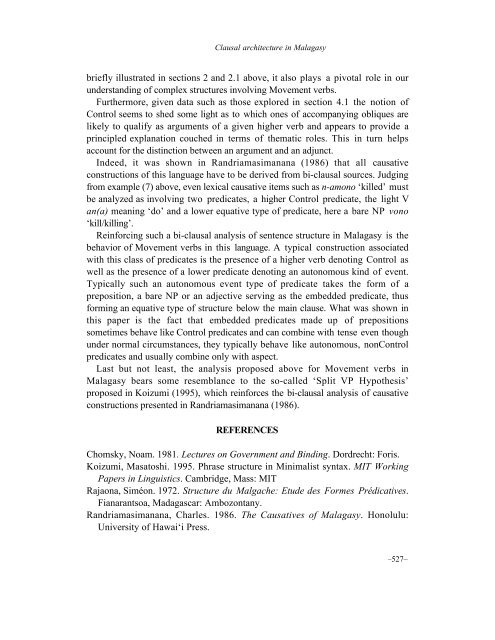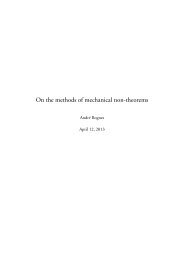Clausal architecture and movement verbs in Malagasy
Clausal architecture and movement verbs in Malagasy
Clausal architecture and movement verbs in Malagasy
You also want an ePaper? Increase the reach of your titles
YUMPU automatically turns print PDFs into web optimized ePapers that Google loves.
<strong>Clausal</strong> <strong>architecture</strong> <strong>in</strong> <strong>Malagasy</strong><br />
briefly illustrated <strong>in</strong> sections 2 <strong>and</strong> 2.1 above, it also plays a pivotal role <strong>in</strong> our<br />
underst<strong>and</strong><strong>in</strong>g of complex structures <strong>in</strong>volv<strong>in</strong>g Movement <strong>verbs</strong>.<br />
Furthermore, given data such as those explored <strong>in</strong> section 4.1 the notion of<br />
Control seems to shed some light as to which ones of accompany<strong>in</strong>g obliques are<br />
likely to qualify as arguments of a given higher verb <strong>and</strong> appears to provide a<br />
pr<strong>in</strong>cipled explanation couched <strong>in</strong> terms of thematic roles. This <strong>in</strong> turn helps<br />
account for the dist<strong>in</strong>ction between an argument <strong>and</strong> an adjunct.<br />
Indeed, it was shown <strong>in</strong> R<strong>and</strong>riamasimanana (1986) that all causative<br />
constructions of this language have to be derived from bi-clausal sources. Judg<strong>in</strong>g<br />
from example (7) above, even lexical causative items such as n-amono ‘killed’ must<br />
be analyzed as <strong>in</strong>volv<strong>in</strong>g two predicates, a higher Control predicate, the light V<br />
an(a) mean<strong>in</strong>g ‘do’ <strong>and</strong> a lower equative type of predicate, here a bare NP vono<br />
‘kill/kill<strong>in</strong>g’.<br />
Re<strong>in</strong>forc<strong>in</strong>g such a bi-clausal analysis of sentence structure <strong>in</strong> <strong>Malagasy</strong> is the<br />
behavior of Movement <strong>verbs</strong> <strong>in</strong> this language. A typical construction associated<br />
with this class of predicates is the presence of a higher verb denot<strong>in</strong>g Control as<br />
well as the presence of a lower predicate denot<strong>in</strong>g an autonomous k<strong>in</strong>d of event.<br />
Typically such an autonomous event type of predicate takes the form of a<br />
preposition, a bare NP or an adjective serv<strong>in</strong>g as the embedded predicate, thus<br />
form<strong>in</strong>g an equative type of structure below the ma<strong>in</strong> clause. What was shown <strong>in</strong><br />
this paper is the fact that embedded predicates made up of prepositions<br />
sometimes behave like Control predicates <strong>and</strong> can comb<strong>in</strong>e with tense even though<br />
under normal circumstances, they typically behave like autonomous, nonControl<br />
predicates <strong>and</strong> usually comb<strong>in</strong>e only with aspect.<br />
Last but not least, the analysis proposed above for Movement <strong>verbs</strong> <strong>in</strong><br />
<strong>Malagasy</strong> bears some resemblance to the so-called ‘Split VP Hypothesis’<br />
proposed <strong>in</strong> Koizumi (1995), which re<strong>in</strong>forces the bi-clausal analysis of causative<br />
constructions presented <strong>in</strong> R<strong>and</strong>riamasimanana (1986).<br />
REFERENCES<br />
Chomsky, Noam. 1981. Lectures on Government <strong>and</strong> B<strong>in</strong>d<strong>in</strong>g. Dordrecht: Foris.<br />
Koizumi, Masatoshi. 1995. Phrase structure <strong>in</strong> M<strong>in</strong>imalist syntax. MIT Work<strong>in</strong>g<br />
Papers <strong>in</strong> L<strong>in</strong>guistics. Cambridge, Mass: MIT<br />
Rajaona, Siméon. 1972. Structure du Malgache: Etude des Formes Prédicatives.<br />
Fianarantsoa, Madagascar: Ambozontany.<br />
R<strong>and</strong>riamasimanana, Charles. 1986. The Causatives of <strong>Malagasy</strong>. Honolulu:<br />
University of Hawai‘i Press.<br />
–527–

















